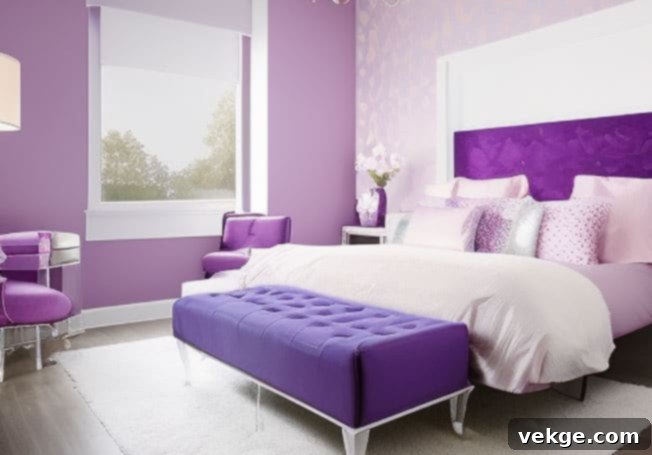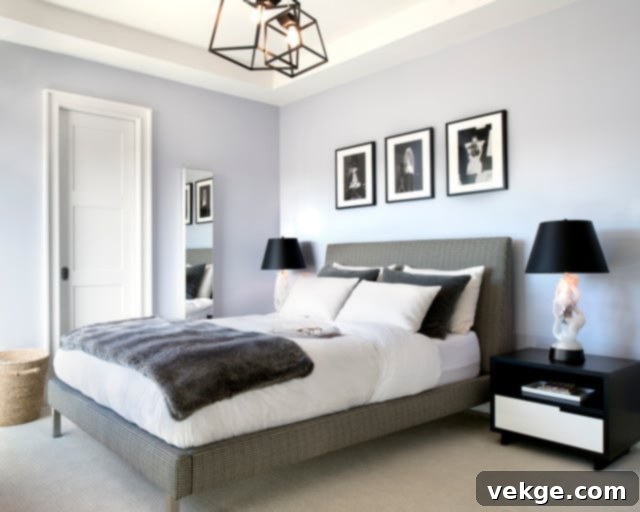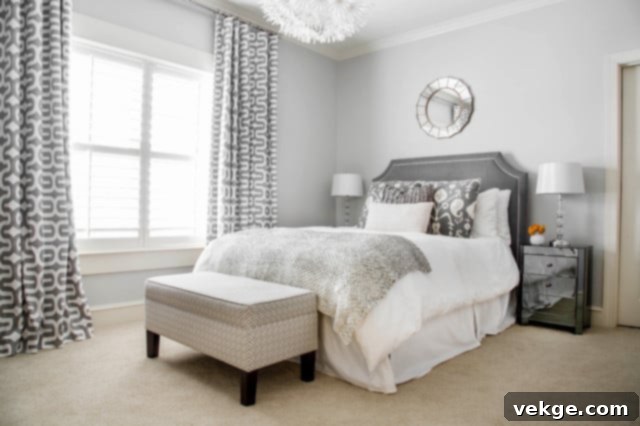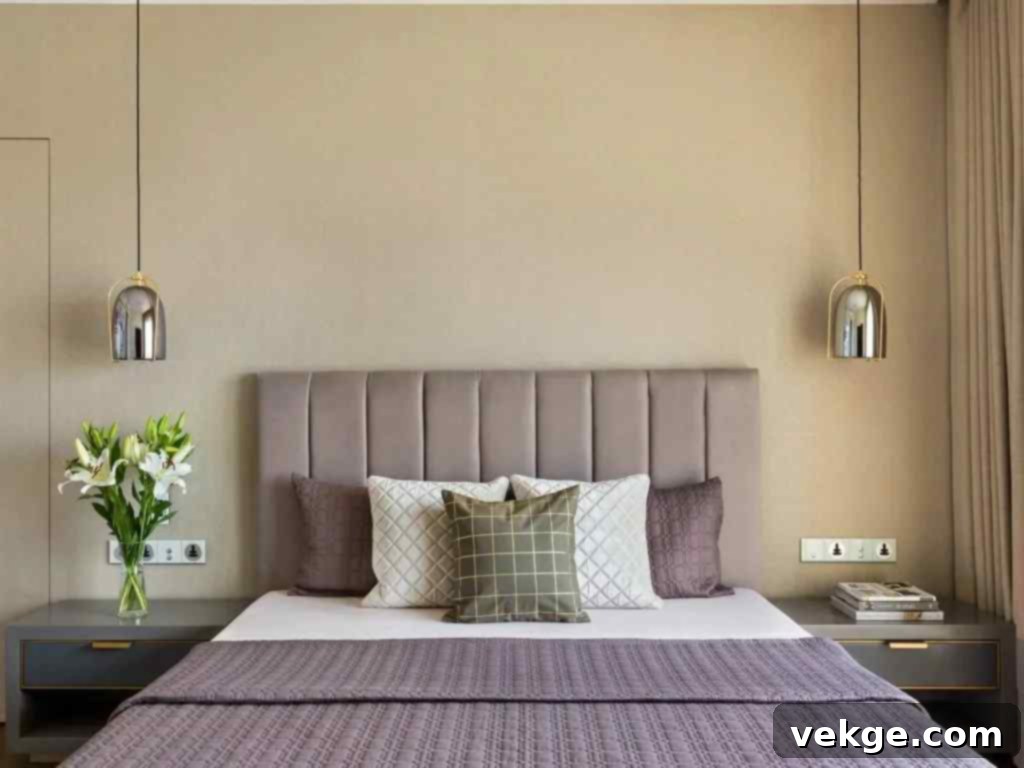Transform Your Sanctuary: The Ultimate Guide to Calming Bedroom Colors for Optimal Sleep & Well-being
The bedroom, a personal sanctuary, plays a pivotal role in our daily lives. It’s not just where we sleep, but where we unwind, recharge, and prepare for the day ahead. The colors we choose for this intimate space can profoundly impact our mood, energy levels, and, most importantly, the quality of our sleep. Scientific studies have even shown that certain hues can significantly lower heart rate and calm the nervous system, with some proving up to 61% more effective than others in promoting relaxation.
Imagine waking up feeling refreshed and invigorated, ready to embrace the day, rather than battling lingering fatigue. This transformation begins with a thoughtful approach to your bedroom’s color palette. But which colors hold this magical power to turn your bedroom into a peaceful oasis, guaranteed to enhance your rest and well-being? This comprehensive guide will count down the most relaxing bedroom colors and accent shades, helping you curate a serene environment that truly supports deep, restorative sleep.
Understanding the Psychology of Color in Your Bedroom
Color psychology, the study of how different hues affect human behavior and mood, is particularly relevant when designing a bedroom. Unlike other areas of your home that might benefit from stimulating colors, the bedroom thrives on shades that evoke peace, comfort, and tranquility. The goal is to create an atmosphere that gently guides your mind and body towards relaxation, away from the day’s stresses. This section delves into the best calming colors, exploring their unique properties and how they contribute to a perfect sleep environment.
When it comes to accents, remember that subtlety is key. Opt for neutral and earthy tones over bright, jarring shades. Incorporating various textures can further enhance the soothing ambiance. Think woven wood, soft rattan, luxurious linen, plush velvet, or cozy knits. These elements add depth and warmth without overstimulating the senses. Let’s explore the perfect sleep-promoting color palette that will transform your bedroom into a haven of calm.
5 Best Calming Colors for Your Bedroom
Light Blue: The Serene Sky and Ocean

Light blue consistently ranks as one of the most effective relaxing bedroom colors, renowned for its ability to instill a profound sense of calm and gentle retreat. Its deep association with open, clear skies and tranquil bodies of water instantly evokes feelings of vastness, peace, and serenity. This peaceful presence makes it an ideal choice for any space dedicated to rest and rejuvenation.
Numerous studies highlight light blue’s unique physiological effects: it has been shown to encourage the body’s production of calming chemicals and effectively lower pulse rate and blood pressure, often more so than other cool colors. Pale blue provides a soft, soothing aesthetic due to its inherently low-contrast appearance, which minimizes visual stimulation. To truly optimize your sleeping environment, consider shades like serene sky blue, gentle powder blue, or the delicate pale Robin’s egg blue. These subtle variations will facilitate a truly peaceful and undisturbed atmosphere in your private sanctuary.
Lavender: The Aromatic Calmer

Lavender is widely cherished for its comforting and calming properties, often linked to the soothing scent of the lavender plant itself, known for its sleep-inducing qualities. This gentle hue brings a soft elegance to any bedroom. A soft pastel lavender, for instance, is exceptionally pale, almost white, with just the slightest whisper of purple, imparting a unique, powdery sophistication. This delicate shade offers a subtle warmth that encourages relaxation without overwhelming the senses.
For those seeking a slightly brighter, fresher feel, a light lilac lavender offers a bit more purple pigment while still maintaining its inherently calming essence. It introduces a vibrant yet gentle touch to your decor. Alternatively, explore a pale lavender-toned gray. This misty, tranquil shade blends beautifully with other neutrals, creating a sophisticated and deeply restful backdrop. The versatility of lavender, from its nearly white pastels to its soft gray infusions, makes it an excellent choice for cultivating a serene and stylish bedroom environment.
Seafoam Green: Ocean’s Whisper

Seafoam green effortlessly captures the soothing essence of the ocean, transporting you to a peaceful seaside escape right within your bedroom walls. With its subtle cool blue undertones, seafoam green possesses a remarkable ability to clear anxious thoughts and invite the mind to a state of profound rest. This makes it an exceptional choice for anyone seeking a tranquil environment to unwind.
This exquisite shade enhances the calming qualities of both blue and gray, offering a refreshing and neutral accent that blends seamlessly into various decor styles. Unlike more vibrant greens that can stimulate energy, seafoam green strikes the perfect balance between chic sophistication and serene peacefulness. It’s a color that not only looks beautiful but actively contributes to a restful atmosphere, encouraging a deeper sense of calm and well-being. Pair it with natural wood elements or soft white linens to amplify its organic, tranquil appeal.
Soft Gray: Sophisticated Serenity

Gray, often considered the ultimate middle-ground color, is a favored choice for those seeking understated elegance and sophisticated tranquility. Pale grays are particularly effective in the bedroom because they offer minimal contrast or color variation, preventing any visual distraction or overstimulation as you prepare for sleep. These soft shades subtly remind us of drifting rain clouds and hazy fog, contributing to a naturally calming and contemplative atmosphere.
When selecting gray, it’s advisable to lean towards lighter shades rather than dark charcoal grays, which can sometimes feel too heavy. For added warmth, consider “greige,” a delightful blend of gray and beige that offers more coziness than pure gray alone. Dove gray is another exquisite soft shade, often featuring a subtle purple tinge, which further enhances its tranquil attributes, creating a truly relaxing aura in the bedroom. A light gray with shimmery undertones can introduce eye-pleasing depth and an even more pacifying effect, making your bedroom a truly serene haven.
White: Pure Peace and Clean Canvas

For ultimate restful vibes and an unrivaled sense of purity, clean white might just be the quintessential choice for your bedroom. While a stark, pure white can sometimes feel sterile, a creamy white with its lovely warm undertones offers a much cozier and more inviting ambiance. This subtle warmth prevents the space from feeling cold or clinical, transforming it into a soft, comforting cloud.
Ivory presents another beautiful warm white option, characterized by gentle yellow undertones that lend it a timeless, vintage quality. It feels both classic and comforting. For a touch of romantic femininity, consider a very pale pink-white hue. With just a hint of blush, it imparts a soft, romantic glow, adding a delicate charm without being overtly bold. Softer whites, in general, are ideal for creating a truly cozy and tranquil bedroom. To enhance this serene palette, accentuate your white bedroom with layers of textures such as rich linen, luxurious velvet, or ethereal sheer drapes, all in tonal white variations. This layering creates depth and interest while maintaining an utterly peaceful and refined aesthetic.
Bedroom Colors You Should Avoid for Optimal Rest

When curating a truly restful bedroom environment, the overarching principle is to steer clear of colors that are overly intense, exceptionally bright, or extreme in their saturation. These hues, while potentially exciting in other areas of the home, can act as stimulants, making it difficult for your mind and body to switch off before bedtime. Here are some specific colors and shades that are generally not recommended for a sleep-promoting space:
- Vibrant Reds: While bold reds might initially appear exciting or passionate, their energetic intensity can be counterproductive for sleep. Red is known to increase heart rate and stimulate activity, making it challenging to unwind and relax. It’s best reserved for spaces where energy and conversation are encouraged, not for restorative rest.
- Neon Hues: Bright neon shades, such as vivid lime green or electric orange, are designed to grab attention and stimulate the visual senses. This high level of visual stimulation is precisely what you want to avoid when trying to calm down and prepare for sleep. They can make a bedroom feel restless and jarring.
- Stark Whites: While soft, warm whites are excellent, flat, unmodulated stark whites can feel surprisingly cold and impersonal. Instead of a serene retreat, they can evoke the sterile atmosphere of a hospital or other public, institutional setting, which is far from conducive to cozy relaxation.
- Deep Black: While a touch of black as an accent can be sophisticated, painting an entire bedroom in deep black can create an environment that feels oppressive and cave-like. The overwhelming darkness, rather than being restful, can feel heavy and even isolating for some individuals, hindering a sense of lightness and openness.
- Rich Chocolate Browns: Deep, rich chocolate browns, though sometimes elegant, can often feel too gloomy or overly serious for a bedroom. They can absorb light and make a space feel smaller and less inviting. Exceptions include lighter, warmer browns like nutmeg, tan, or soft beige, which offer earthy comfort without the heavy intensity.
- Grayish Purples (Muddy Purples): Unlike the airy, soothing qualities of light lavender, darker, muddy purples with strong gray undertones tend to feel weighed down and somewhat somber. These tones can lack the vibrancy needed to feel inviting while also missing the lightness required for true tranquility, leading to a dull or even melancholic atmosphere.
- Bright Yellow: Very bright, brilliant yellows, reminiscent of a sunshiny lemon or a taxi cab, are inherently awakening and energizing. This stimulating effect, while great for kitchens or workspaces, is entirely inappropriate for a sleep setting. Bright yellow can make it difficult for the mind to settle and transition into a restful state.
Summing Up: Cultivating Your Ideal Sleep Sanctuary
Creating the bedroom of your dreams, a tranquil haven where you can truly unwind and recharge, should be a top priority for anyone seeking a quiet escape from the demands of daily life. The thoughtful choice of calming bedroom colors for adults has a profound and undeniable impact on cultivating the ideal relaxing ambiance necessary for optimal rest and well-being.
The most calming shades for bedrooms consistently lean towards lighter, softer, and cooler tones, often with just the slightest hint of pigmentation. These subtle hues work in harmony to create an environment that gently lowers stress levels and prepares the mind and body for restorative sleep. When these signature shades are expertly layered with soft, plush textures – think luxurious throws, sumptuously soft rugs, and inviting drapery – they collectively set the perfect stage for an undisturbed siesta, enveloping you in comfort and peace.
Armed with this guide, you are now empowered to choose your favorite colors with confidence, transforming your bedroom into a personalized sanctuary. Embrace these principles, and look forward to waking up feeling truly energized, refreshed, and ready to conquer each new day with renewed vitality. Your best sleep awaits!
